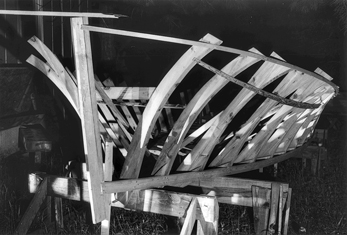Born in 1904, Brady Lewis was said to have an “innate sense of the relationship between the curves and lines of a boat and her sea-keeping abilities”. Although he lacked formal training in boat-building, he was guided by his intuition (Conoley et al. 2007:43). Lewis utilized a technique called “rock of the eye” or “rack of the eye”, in which the builder would step back, reassess the construction and make corrections where needed (Conoley et al. 45). Another name for it is just “eye method”. Rubin discusses this when Lewis assisted him in building his boat (Rubin 1998:226-7). One his first efforts at boat building was Dogfly, a 26-foot skiff, completed in 1938 (Conoley et al. 2007:43).

He is more notable from his innovation of utilizing a flared bow to his boats (Conoley et al. 2007:33). To backyard boat builders on the Core Sound (like those on Harker’s Island) they use the term, ‘flar’ instead. The first boat with a flar, built by Lewis, was Jean & Dale. The boat was made for Harry M. Lewis, for sink-net and long-haul fishing (Conoley et al. 2007:44-45). Brady selected frames from cedar trees grown on the core sound which could have unusual and gnarly shapes. Brady also attached juniper strip planking with copper nails into the bow flar” (Conoley et al. 45). Jean & Dale also included a cabin doghouse, a compartment fixed to the cabin but larger than most other boat wheelhouses. The boat “survived over 65 years, a fire and two sinkings”. Jean & Dale was currently restored by and is on display at the Core Sound Waterfowl Museum.
Brady Lewis’s innovation lives on in the several boats built on Harker’s Island. Prominent Harker’s Island boat builders, such as James T. Gillikin, James and Earl L. Rose, Julian Guthrie and Clem Willis worked for Lewis before they created their own businesses (Prioli 2002:115).
By Alexander Owens
